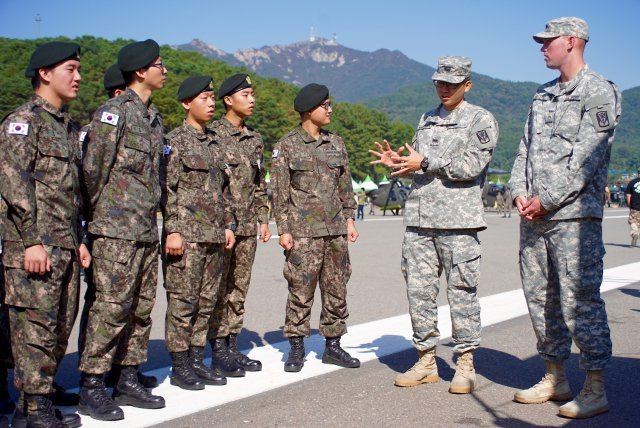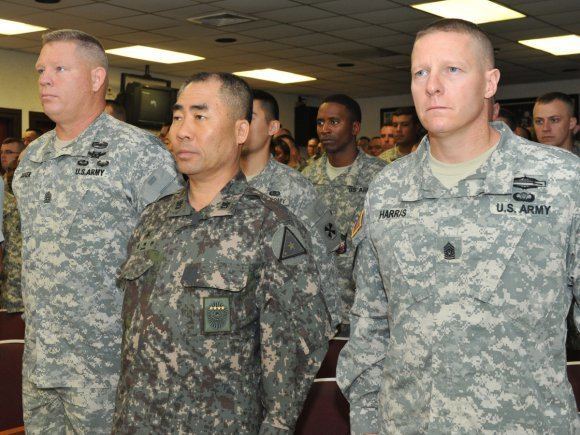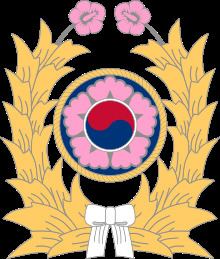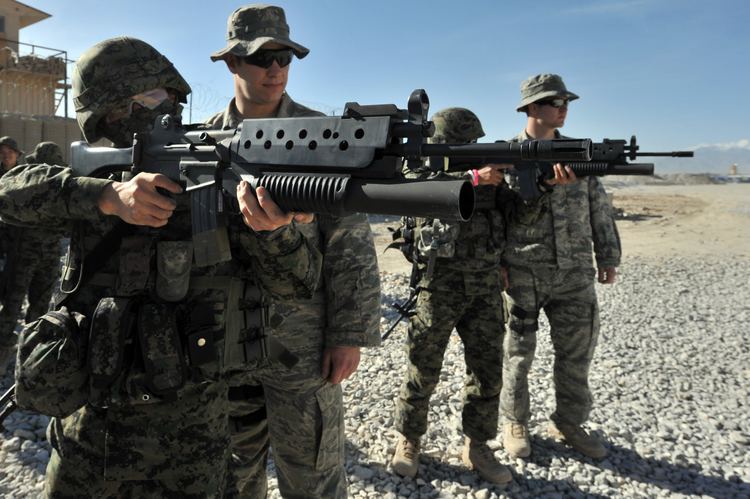Role Ground warfare Founded 5 September 1948 | Type Army Founder Choi Hong Hi | |
 | ||
Size 495,000 (2014)552 aircraft (2014) Motto "A Strong Friend, Republic of Korea Army"; (Korean: 《강한친구 대한민국 육군》) Similar Republic of Korea Armed Fo, Republic of Korea Marine C, Republic of Korea Air Force, Republic of Korea Navy, Korean People's Army | ||
rok army republic of korea army training center full length pr film
The Republic of Korea Army (ROKA; Korean: 대한민국 육군; Hanja: 大韓民國 陸軍; Revised Romanization: Daehanminguk Yuk-gun), also known as the ROK Army, is the army of South Korea, responsible for ground-based warfare. It is the largest of the military branches of the South Korean armed forces with 495,000 members as of 2014. This size is maintained through conscription; South Korean men must complete 21 months of military service between the age of 18 and 35.
Contents
- rok army republic of korea army training center full length pr film
- rok army republic of korea army training center pr film
- History
- Today
- Equipment
- Republic of Korea Army Headquarters
- First Republic of Korea Army FROKA 1
- Second Operational Command 2
- Third Republic of Korea Army TROKA 3
- Military ranks
- Warrant officers
- References

The army will take the brunt of the personnel reduction planned as part of the Defense Reform 307. Associated with this personnel reduction would be a significant reduction in the ROK Army force structure, in particular decreasing the current force of 47 divisions (active duty/reserve) and 495,000 soldiers down to a force of about 38 divisions (active duty/reserve) and 400,000 soldiers.

rok army republic of korea army training center pr film
History

The modern South Korean army traces its lineage back to the Gwangmu Reform, when the Beolgyegoon was established by Emperor Gojong in 1881. The 1st of every October is celebrated in South Korea as Armed Forces Day. It commemorates the day during the Korean War when units of the ROK Army first crossed the 38th Parallel, thus leading the UN Coalition north into North Korean territory for the first time.
Today
The South Korean army is structured to operate in both the mountainous terrain native to the Korean Peninsula (70% mountainous) and in North Korea with its 950,000 strong Korean People's Army Ground Force, two-thirds of which is permanently garrisoned in the frontline near the DMZ. The current administration has initiated a program over the next two decades to design a purely domestic means of self-defense, whereby South Korea would be able to fully counter a North Korean attack.
The ROK Army was formerly organized into 3 armies: the First Army (FROKA), Third Army (TROKA) and Second Operational Command. Each with its own headquarters, corps, and divisions. The Third Army was responsible for the defense of the capital as well as the western section of the DMZ. The First Army was responsible for the defense of the eastern section of the DMZ whereas the 2nd OC formed the rearguard.
Under a restructuring plan aimed at reducing redundancy, the Second ROK Army was converted as the Second Operational Command on October 31, 2007, and the First and Third ROK Armies will be merged as the First Operations Command in 2014.
Equipment
The army consists of 495,000 troops, approximately 2,400-2,500 tanks, 2,700 armored fighting vehicles, 5,800 artillery pieces, 60 guided missile systems, and 600 helicopters as of 2014. Main battle tank types include: 880 M48 Patton series and its upgrades such as M48A3K, M48A5, and M48A5K, 33 Soviet T-80U and 2 T-80UK (given by Russia to pay off debt), as well as 1,524 K1A1 and K1 tanks, which bear a 120 mm smoothbore gun and are of local manufacture. The future replacement for the K1 and K1A1 MBTs has been named the K2 Black Panther (흑표;黑豹 Heukpyo), which will be fitted with a 1500 hp MTU-based engine, 55-caliber 120 mm main gun with autoloader. The new tank will also feature radar equipment as well as all-bearing laser detection and defense systems, anti-missile active protection, and heavy reactive armor and sensor package comparable to the American M1A2 Abrams and German Leopard 2A6. The ROK Army is planning to field approximately 390 Black Panthers.
In addition Turkey already manufactures the indigenous T-155 howitzer, which have been exported to South Korea, as well as the ZMA series TIFV's which saw action in UN peacekeeping operations (PKO) as part of the Malaysian peacekeeping forces. A variation of the K200, the KAFV's can be retrofitted to bear a 90 mm cannon, 40 mm grenade turret, M230-1 Chain gun Turret, or MK-30 Chaingun Turret. A replacement for K200 series IFVs are currently being tested, designated as K21 KNIFV (Korea Next generation Infantry Fighting Vehicle), which will have various capabilities for both land and naval warfare. The initial production is set for 2008, with the ROKA planning to field approximately 1,000 units until 2015.
The K21 KNIFV's chassis will be constructed entirely out of fiberglass, reducing the vehicle's load and enabling it to travel at higher speeds without bulky and powerful engines. When constructed, the NIFV will be lighter than other IFVs, including the American Bradley series and Russian BMP series, increasing both speed and payload.
The ROK Army also fields the mobile K-SAM "Pegasus"(천마/天馬; Cheonma), fitted with 8 missiles that fly at maximum speeds of mach 2.6, and the K-30 "Biho" series, which features a 30 mm twin gun system for anti-aerial fire support.
Besides having vehicles and equipment of their own design as well as American models, the ROK Army also possesses inventories of Russian-built AFVs, including BMP-3 IFVs and T-80U MBTs, given by the Russian government to pay off the financial debt owed to South Korea. Other notable foreign equipment in service with the ROK Army includes the Mistral MANPADS.
A new infantry rifle, the Daewoo K11 entered service in 2010. The overall concept of this weapon is similar to the American OICW.
Republic of Korea Army Headquarters (대한민국 육군본부)
First Republic of Korea Army (FROKA) (제1야전군)
Second Operational Command (육군 제2작전사령부)
(Formerly known as the Second Republic of Korea Army (SROKA))
Third Republic of Korea Army (TROKA) (제3야전군)
Military ranks
Officer ranks can be learned fairly easily if one sees the pattern. "So" (小) equals small; "Jung" (中) equals medium; "Dae" (大) equals large.
"Jun" (准) equals equivalent, used for Warrant Officer and 1 star general to ensure that they are regarded as officer/general, although these ranks are lower than the same grade with "So" rank.
"Won" (元) equals principal, only used for Won-Su, General of the Army.
Each of these is coupled with "wi" (尉) equals company grade, "ryung" (領) equals field grade, and "jang" (將) equals general.
NCO rank is same as officer. "Ha" (下) equals lower; "Jung" (中) equals medium; "Sang" (上) equals high; "Won" (元) equals principal, because this title is named after Won-Su, to ensure that this rank is higher than Sang-sa.
Each of these is coupled with "Sa" (士) equals sergeant, although actual 'sergeant' rank is "Byeong-jang".
This system is due to the hanja or Sino-Korean origin of the names.
LINK : http://i.kdaq.empas.com/imgs/qrsi.tsp/8061636/10565009/0/1/A/photo.jpg
Warrant officers
¹: No one has yet held the rank of Won-su in the history of the ROK Armed Forces.
²: The Jun-wi (Warrant Officer)'s insignia is in gold color while the ones of Second Lieutenant and higher are in silver color.
